belt BMW M3 CONVERTIBLE 2001 E46 Owner's Manual
[x] Cancel search | Manufacturer: BMW, Model Year: 2001, Model line: M3 CONVERTIBLE, Model: BMW M3 CONVERTIBLE 2001 E46Pages: 195, PDF Size: 1.96 MB
Page 10 of 195

Contents
Overview
Controls and features
Cockpit16
Instrument cluster18
Indicator and warning lamps20
Multifunction steering wheel
(MFL)24
Hazard warning flashers25
Warning triangle25
Refueling26
Fuel specifications27
Tire inflation pressures27
Opening and closing:
Keys32
Electronic vehicle
immobilizer33
Central locking system33
Opening and closing – via the
door lock34
Opening and closing – via the
remote control35
Opening and closing – from
inside38
Luggage compartment lid39
Luggage compartment40
Alarm system42
Electric power windows44
Convertible top45
Adjustments:
Seats48
Mirrors52
Seat and mirror memory54
Steering wheel55
Car Memory, Key Memory55
Passenger safety systems:
Safety belts57
Transporting children safely58
Airbags61
Rollover protection system64
Driving:
Steering/Ignition lock66
Starting the engine66
Switching off the engine67
Parking brake67
Manual transmission68
Turn signal indicator/Headlamp
flasher69
Washer/Wiper system69
Rear window defroster71
Cruise control71
Everything under control:
Odometer73
Tachometer73
Engine oil temperature gauge73
Fuel gauge74
Coolant temperature gauge74
Service Interval Display75
Check Control76
Clock76
Computer77
Technology for safety and
convenience:
Park Distance Control (PDC)79
Dynamic Stability Control
(DSC)80
Tire Pressure Warning (RDW)81
M Engine dynamics control83
Contents
Page 12 of 195

Contents
Owner service procedures
Advanced technology
Technical data
Replacement procedures:
Onboard tool kit146
Windshield wiper blades146
Lamps and bulbs146
Repairing a flat tire153
Battery157
Fuses160
Replacing microfilter and
activated-charcoal filter161
In case of electrical
malfunction:
Fuel filler door161
Convertible top162
Assistance, giving and
receiving:
Jump-starting164
Towing the vehicle165Airbags168
Radio reception169
Dynamic Stability Control
(DSC)170
Safety belt tensioner170
M3 Engine concept171
Rain sensor172
Interior rearview mirror with
automatic dimming
feature173
Xenon lamps174
Rollover protection system175Engine data178
Dimensions179
Weights180
Capacities181
Electrical system182
Drive belts182
Page 19 of 195
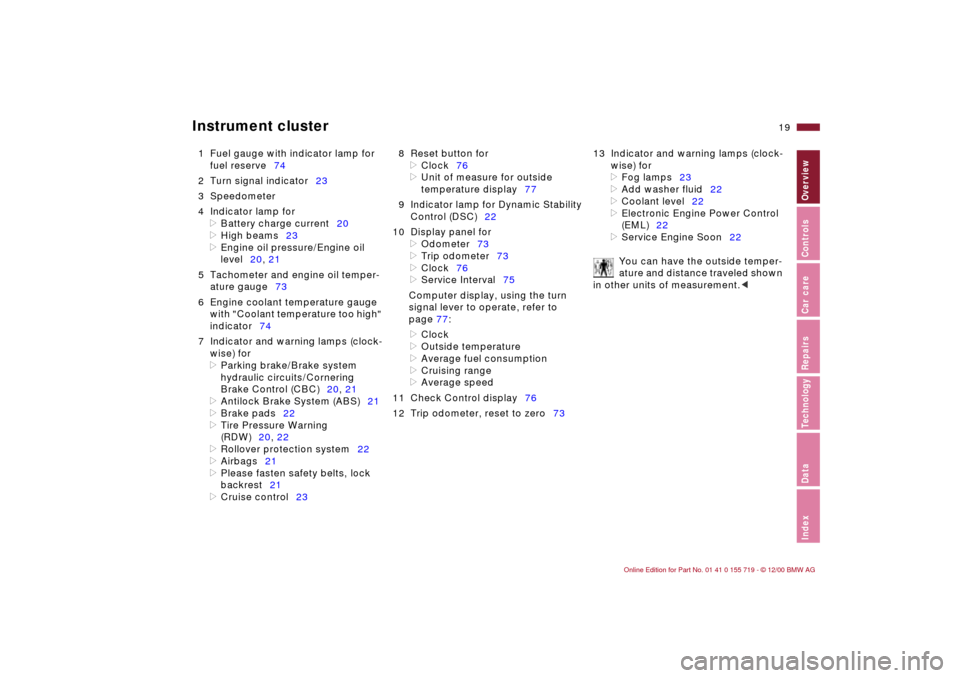
19n
IndexDataTechnologyRepairsCar careControlsOverview
Instrument cluster
1 Fuel gauge with indicator lamp for
fuel reserve74
2 Turn signal indicator23
3 Speedometer
4 Indicator lamp for
>
Battery charge current20
>
High beams23
>
Engine oil pressure/Engine oil
level20, 21
5 Tachometer and engine oil temper-
ature gauge73
6 Engine coolant temperature gauge
with "Coolant temperature too high"
indicator74
7 Indicator and warning lamps (clock-
wise) for
>
Parking brake/Brake system
hydraulic circuits/Cornering
Brake Control (CBC)20, 21
>
Antilock Brake System (ABS)21
>
Brake pads22
>
Tire Pressure Warning
(RDW)20, 22
>
Rollover protection system22
>
Airbags21
>
Please fasten safety belts, lock
backrest21
>
Cruise control238 Reset button for
>
Clock76
>
Unit of measure for outside
temperature display77
9 Indicator lamp for Dynamic Stability
Control (DSC)22
10 Display panel for
>
Odometer73
>
Trip odometer73
>
Clock76
>
Service Interval75
Computer display, using the turn
signal lever to operate, refer to
page 77:
>
Clock
>
Outside temperature
>
Average fuel consumption
>
Cruising range
>
Average speed
11 Check Control display76
12 Trip odometer, reset to zero7313 Indicator and warning lamps (clock-
wise) for
>
Fog lamps23
>
Add washer fluid22
>
Coolant level22
>
Electronic Engine Power Control
(EML)22
>
Service Engine Soon22
You can have the outside temper-
ature and distance traveled shown
in other units of measurement.
<
Page 20 of 195
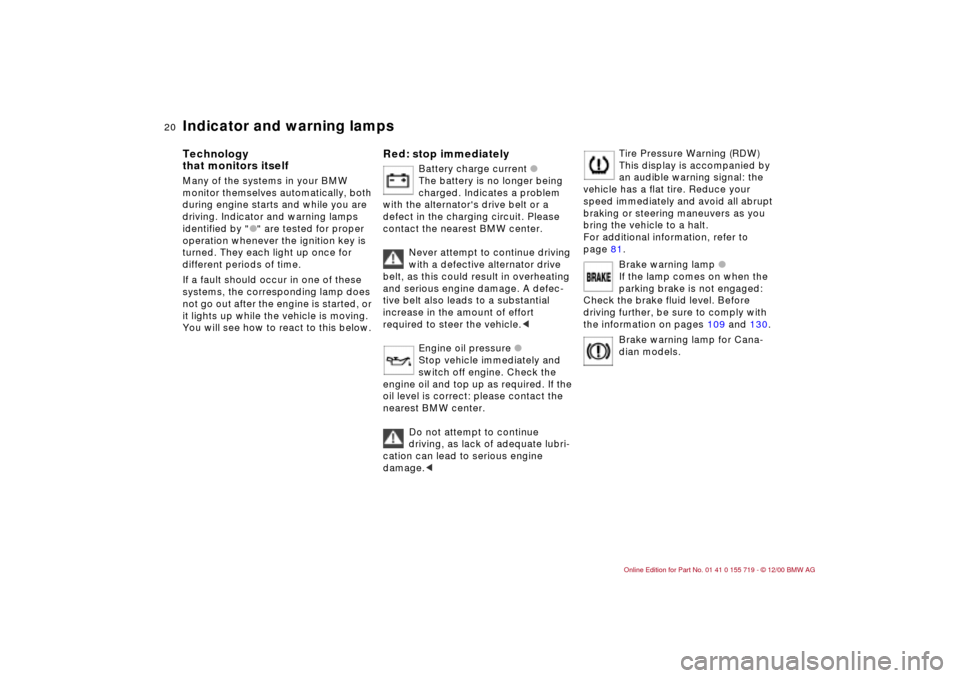
20n
Indicator and warning lamps
Technology
that monitors itself
Many of the systems in your BMW
monitor themselves automatically, both
during engine starts and while you are
driving. Indicator and warning lamps
identified by "
l
" are tested for proper
operation whenever the ignition key is
turned. They each light up once for
different periods of time.
If a fault should occur in one of these
systems, the corresponding lamp does
not go out after the engine is started, or
it lights up while the vehicle is moving.
You will see how to react to this below.
Red: stop immediately
Battery charge current
l
The battery is no longer being
charged. Indicates a problem
with the alternator's drive belt or a
defect in the charging circuit. Please
contact the nearest BMW center.
Never attempt to continue driving
with a defective alternator drive
belt, as this could result in overheating
and serious engine damage. A defec-
tive belt also leads to a substantial
increase in the amount of effort
required to steer the vehicle.
<
Engine oil pressure
l
Stop vehicle immediately and
switch off engine. Check the
engine oil and top up as required. If the
oil level is correct: please contact the
nearest BMW center.
Do not attempt to continue
driving, as lack of adequate lubri-
cation can lead to serious engine
damage.
<
Tire Pressure Warning (RDW)
This display is accompanied by
an audible warning signal: the
vehicle has a flat tire. Reduce your
speed immediately and avoid all abrupt
braking or steering maneuvers as you
bring the vehicle to a halt.
For additional information, refer to
page 81.
Brake warning lamp l
If the lamp comes on when the
parking brake is not engaged:
Check the brake fluid level. Before
driving further, be sure to comply with
the information on pages 109 and 130.
Brake warning lamp for Cana-
dian models.
Page 21 of 195
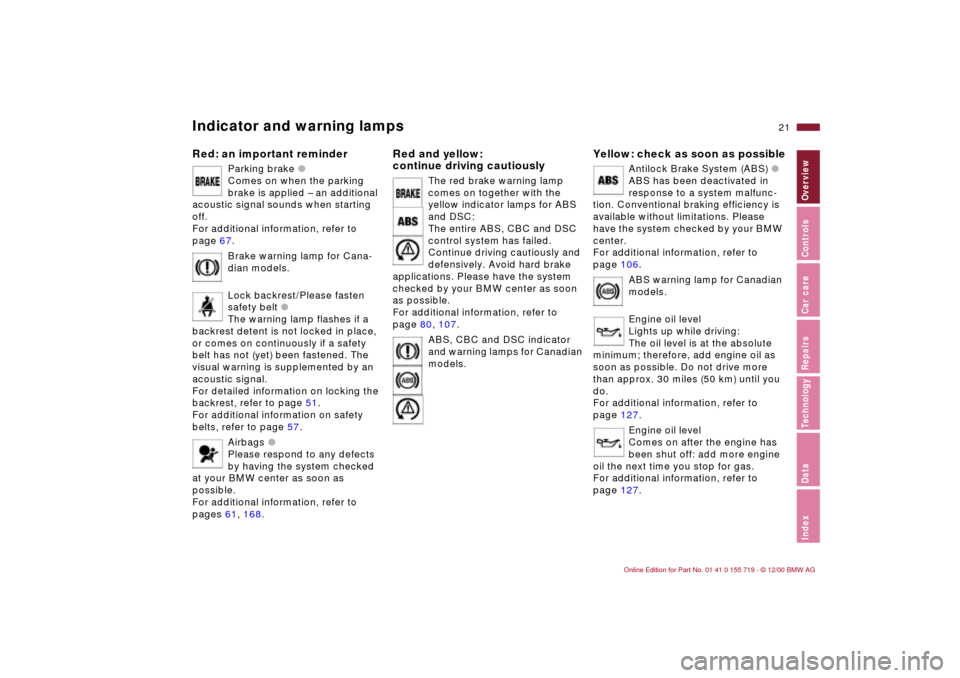
21n
IndexDataTechnologyRepairsCar careControlsOverview
Indicator and warning lampsRed: an important reminder
Parking brake l
Comes on when the parking
brake is applied – an additional
acoustic signal sounds when starting
off.
For additional information, refer to
page 67.
Brake warning lamp for Cana-
dian models.
Lock backrest/Please fasten
safety belt l
The warning lamp flashes if a
backrest detent is not locked in place,
or comes on continuously if a safety
belt has not (yet) been fastened. The
visual warning is supplemented by an
acoustic signal.
For detailed information on locking the
backrest, refer to page 51.
For additional information on safety
belts, refer to page 57.
Airbags l
Please respond to any defects
by having the system checked
at your BMW center as soon as
possible.
For additional information, refer to
pages 61, 168.
Red and yellow:
continue driving cautiously
The red brake warning lamp
comes on together with the
yellow indicator lamps for ABS
and DSC:
The entire ABS, CBC and DSC
control system has failed.
Continue driving cautiously and
defensively. Avoid hard brake
applications. Please have the system
checked by your BMW center as soon
as possible.
For additional information, refer to
page 80, 107.
ABS, CBC and DSC indicator
and warning lamps for Canadian
models.
Yellow: check as soon as possible
Antilock Brake System (ABS) l
ABS has been deactivated in
response to a system malfunc-
tion. Conventional braking efficiency is
available without limitations. Please
have the system checked by your BMW
center.
For additional information, refer to
page 106.
ABS warning lamp for Canadian
models.
Engine oil level
Lights up while driving:
The oil level is at the absolute
minimum; therefore, add engine oil as
soon as possible. Do not drive more
than approx. 30 miles (50 km) until you
do.
For additional information, refer to
page 127.
Engine oil level
Comes on after the engine has
been shut off: add more engine
oil the next time you stop for gas.
For additional information, refer to
page 127.
Page 30 of 195
30n
Locks and security systems:
Keys32
Electronic vehicle
immobilizer33
Central locking system33
Opening and closing – via the
door lock34
Opening and closing – via the
remote control35
Opening and closing – from
inside38
Luggage compartment lid39
Luggage compartment40
Alarm system42
Electric power windows44
Convertible top45
Adjustments:
Seats48
Mirrors52
Seat and mirror memory54
Steering wheel55
Car Memory, Key Memory55
Passenger safety systems:
Safety belts57
Transporting children safely58
Airbags61
Rollover protection system64
Controls
Page 48 of 195

48n
For your personal safety when adjusting
the seat position, please follow the
instructions below carefully:
Never try to adjust your seat while
driving the vehicle. The seat could
respond with an unexpected move-
ment, and the ensuing loss of vehicle
control could lead to an accident.
Be sure that the safety belt remains
firmly against your body at all times. In
the event of a frontal impact, a loose lap
belt could slide over the hips, leading to
abdominal injury. In addition, the safety
belt's restraint effectiveness is reduced
if the belt is worn loosely.
Never ride with the backrest reclined to
an extreme angle (especially important
for the front passenger to remember). If
you do so, there is a risk that you will
slide under the safety belt in an acci-
dent, thus reducing the protection
provided by the safety belt.<
Correct sitting posture To reduce strain on the spinal column,
sit all the way back in the seat and rest
your back fully against the backrest.
The ideal sitting posture is achieved
with your head extending from your
spine in a straight line.
For long-distance driving, you may wish
to increase the backrest tilt angle
slightly to reduce muscular tension. You
should be able to grasp the steering
wheel at its highest point with your
arms slightly bent.
1 Tilt angle
2 Backward/Forward adjustment
3 Cushion height
4 Backrest angle
Comply with the preceding adjust-
ment instructions, as otherwise
personal safety will be diminished.<
Seat adjustment
Page 51 of 195

51n
IndexDataTechnologyRepairsCar careControlsOverview
Head restraints Entering the rear
Do not remove the rear head
restraints as this would damage
them.<
For further information, please consult
your BMW center.
Do not use the rear head
restraints as storage shelves.
Always keep the travel path clear for
the rollover protection system. Never
attach any type of protective coverings
to the head restraints (refer also to the
labeling on the head restraints).<
The seat-integrated safety belt system
(SGS) ensures easier entry in the rear.
1 Lift lever 1 up and tilt the backrest
forward
2 Press and hold down button 2 in the
direction of travel until the seat has
moved into the desired position
3 Fold back and lock the backrest after
entering the rear
4 Press and hold button 2 against the
direction of travel. The seat moves
back into its previous position. If you
release button 2 beforehand, the seat
will stop in its current position.
You can lock a backrest that has
been tilted forward. This makes
sense when, for instance, someone is
climbing into the rear on an incline. To
do this, press against the backrest until
you hear it click into place. To move it
back into place, you do not need to
unlock it first by moving lever 1.<
Lock both backrests while driving,
otherwise there is a danger of an
unexpected movement causing an
accident.<
The indicator lamp in the instrument
cluster flashes when the backrest is not
locked, refer to page 21.
Page 57 of 195

57n
IndexDataTechnologyRepairsCar careControlsOverview
If the safety belt system has been
subjected to the stresses involved
in an accident or otherwise damaged:
have the entire safety belt mechanism
replaced by your BMW center, includ-
ing the safety belt tensioner. In addi-
tion, have your BMW center inspect the
safety belt anchors. If a child restraint
system was in the vehicle during an
accident, consult the manufacturer's
instructions regarding replacement.<
For care instructions, refer to page 135.
Drive with your safety belt onFasten your safety belt before starting
off.
Before putting your safety belts on
in the rear, take them out of the
holder.<
To fasten: make sure you hear the
catch engage in the belt buckle.
To release: press the red button in the
buckle. Hold the belt and guide it back
into its reel.
For your safety, comply with the
following instructions for wearing
safety belts. If you do not, the safety
belts may not be able to provide their
maximum protection. The following
information also applies to your
passengers:
Never allow more than one person to
wear a single safety belt. Never allow
infants or small children to ride in a
passenger's lap.
Untwist the safety belt before putting it
on, and wear it so that it lies as snugly
as possible over your abdomen and
shoulder, and do not let it rub against
any hard or fragile objects. Never route
the belt across your neck, do not run it
across sharp edges and ensure that the
belt does not become caught
or jammed.
Avoid wearing bulky clothing and pull
on the belt periodically to re-tension it
over your shoulders. In the event of a
frontal impact, a loose lap belt could
slide over your hips, leading to abdom-
inal injury. In addition, the safety belt's
restraint effectiveness is reduced if the
belt is worn loosely.
Expectant mothers should always wear
their safety belts, taking care to position
the lap belt against the lower hips,
Safety belts
Page 58 of 195
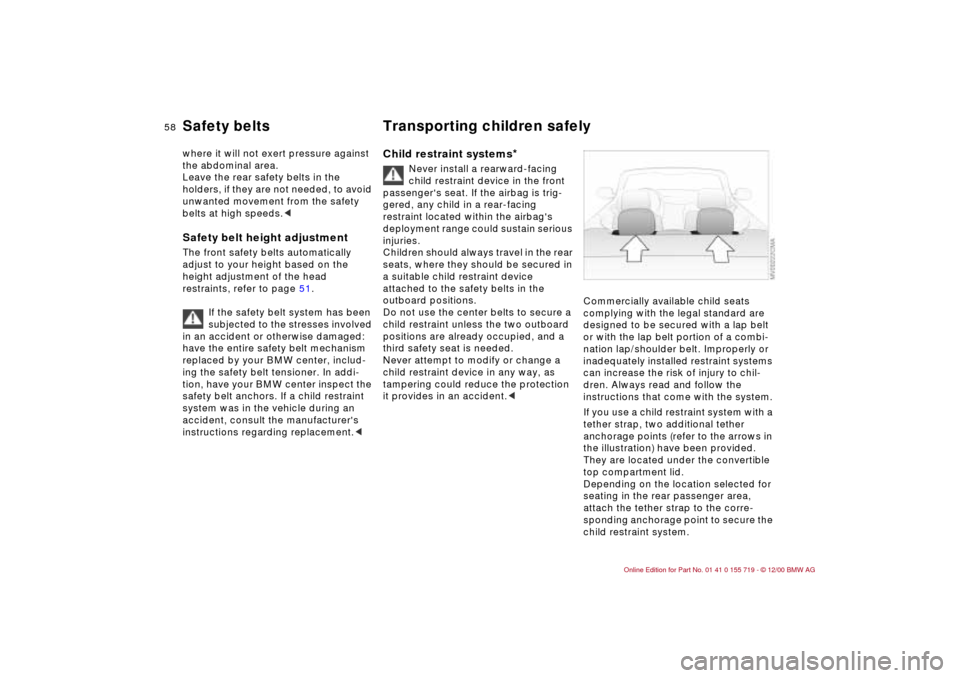
58n
Safety belts Transporting children safelywhere it will not exert pressure against
the abdominal area.
Leave the rear safety belts in the
holders, if they are not needed, to avoid
unwanted movement from the safety
belts at high speeds.< Safety belt height adjustmentThe front safety belts automatically
adjust to your height based on the
height adjustment of the head
restraints, refer to page 51.
If the safety belt system has been
subjected to the stresses involved
in an accident or otherwise damaged:
have the entire safety belt mechanism
replaced by your BMW center, includ-
ing the safety belt tensioner. In addi-
tion, have your BMW center inspect the
safety belt anchors. If a child restraint
system was in the vehicle during an
accident, consult the manufacturer's
instructions regarding replacement.<
Child restraint systems
*
Never install a rearward-facing
child restraint device in the front
passenger's seat. If the airbag is trig-
gered, any child in a rear-facing
restraint located within the airbag's
deployment range could sustain serious
injuries.
Children should always travel in the rear
seats, where they should be secured in
a suitable child restraint device
attached to the safety belts in the
outboard positions.
Do not use the center belts to secure a
child restraint unless the two outboard
positions are already occupied, and a
third safety seat is needed.
Never attempt to modify or change a
child restraint device in any way, as
tampering could reduce the protection
it provides in an accident.<
Commercially available child seats
complying with the legal standard are
designed to be secured with a lap belt
or with the lap belt portion of a combi-
nation lap/shoulder belt. Improperly or
inadequately installed restraint systems
can increase the risk of injury to chil-
dren. Always read and follow the
instructions that come with the system.
If you use a child restraint system with a
tether strap, two additional tether
anchorage points (refer to the arrows in
the illustration) have been provided.
They are located under the convertible
top compartment lid.
Depending on the location selected for
seating in the rear passenger area,
attach the tether strap to the corre-
sponding anchorage point to secure the
child restraint system.